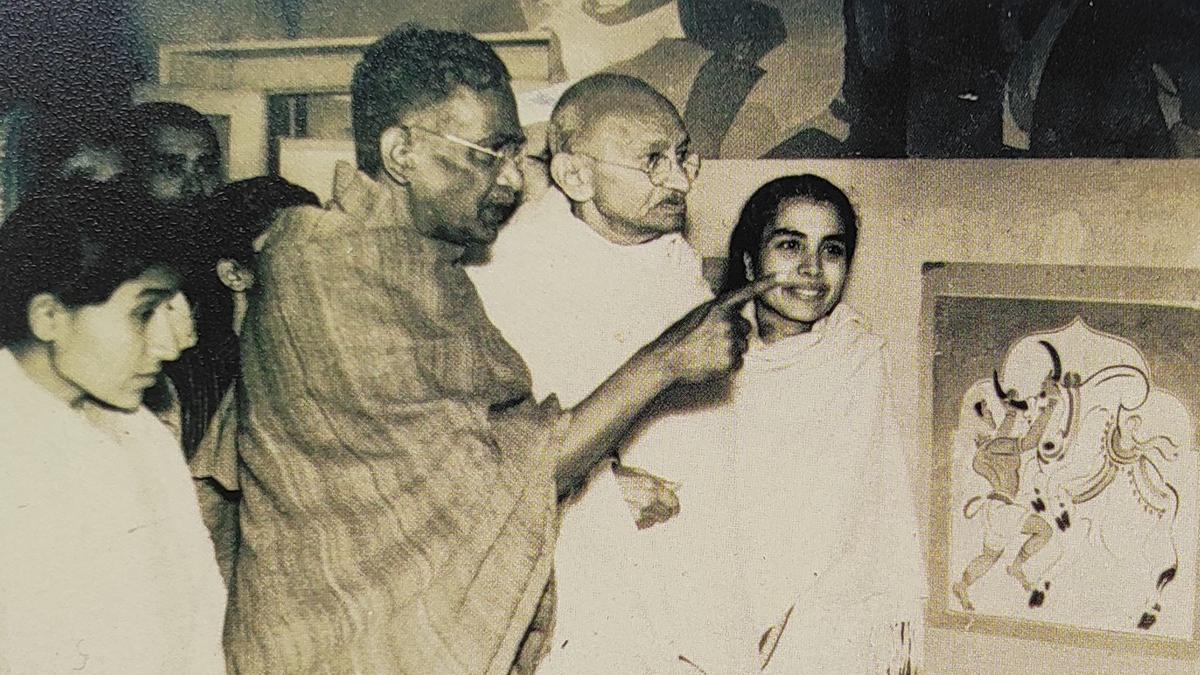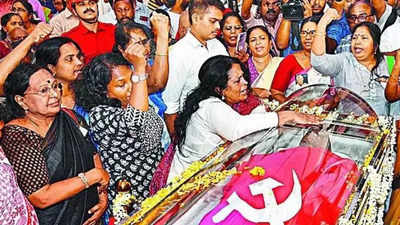“A man who could make art out of anything” was how Mahatma Gandhi addressed Nandalal Bose, the legendary artist from West Bengal. The National Gallery of Modern Art (NGMA) in Delhi houses 6,800 paintings of Bose who made even the Indian Constitution his canvas. The 22 hand-drawn illustrations that adorn the pages of the first Indian Constitution manuscript were commissioned to Bose and his team.
Haripura panels, commissioned by none other than Gandhi himself for the Haripura Congress in 1938, is one of the most famous works of Bose whose works have been declared as National Treasures. Of the 400 panels that were drawn for the exhibition 77 are currently on display at the National Gallery of Modern Arts, Bengaluru. ‘Cotton Spinning’ from Haripura Panels Art as a uniting force In 1936, the 50th session of the Indian National Congress was held in Faizpur, presided over by Nehru.

The first Congress session in a backward rural setting drew peasants in large numbers and saw a record participation. Bose had an important role in designing the pavilion of the Faizpur Congress in 1936. “After the Faizpur Congress, Gandhi realised the potential of art to unite people, and he thought it could be further exploited at the Haripura Congress.
So, he insisted on an exhibition by Bose,” says art historian Dr. Deepak Kannal while leading a Haripura Panels Walk at NGMA, Bengaluru. “The corpus of work was so large and it was not easy to do it in the given time.
But he took the challenge and fulfilled it,” he adds. According to writings by eminent artist K.G.
Subramanyan, who was also a disciple of Bose, 400 painted wall insets or posters were created, of which about 100 were done by Bose himself and the rest by his associates. The paintings depicted the everyday lives of rural Indians so that the masses could connect to them. ‘Tiller of the soil’ Master Moshai Addressed as master moshai by his beloved, Bose nourished the artist in him under the tutelage of Abanindranath Tagore.
Later he also became the principal of Kala Bhavan at Shanti Niketan. “The efforts of the Bengal School of art were to revive the Indian language in art. They tried to study Indian miniature art, Ajanta paintings and so on, and imbibe those elements into contemporary paintings.
It was very similar to neoclassicism in 19th century France when French artists tried to revive the Greek and Roman classical idiom during Napolean’s reign,” explains Kannal. ‘Chrysanthemum with a Gray bird’ In India, in the early 20th century, the Swadeshi movement gained momentum with its epicentre being Bengal. This reflected in the art of the period and largely in the Bengal school.
Rabindranath Tagore, however, being an internationalist who believed in the idea of Viswamanav, was critical of many developments during the Swadeshi movement although he believed in the idea of Indian independence. “That must have been a great challenge for Nandalal Bose. After training in Bengal School, he started teaching in Shantiniketan and was given the charge to lead the art school there.
There he must have undergone tremendous turmoil, but it seems that he faced that challenge very successfully. He did not surrender his indigenous idiom. But at the same time, it seems that he gave a contemporary undercurrent to it,” observes Kannal.
Dr. Deepak Kannal at NGMA, Bengaluru| Photo Credit:The Hindu According to Kannal, the Haripura panels are not only Swadeshi, but contemporary Swadeshi. “It was an outcome of a pan-Indian and a retrospective understanding of visual arts.
Nanda Babu not only borrowed from Ajanta, Mughal or Rajasthani paintings, but he tried to understand Indian art and its language in retrospective and introduce that language in these Haripura panels.” Multiple sources After Gandhiji’s briefing, Bose stayed at Vithal Nagar near Haripura several days before the Congress and travelled widely. Kannal believes that during this period he must have come across the manuscript paintings in Gujarat.
‘Mughal Warrior’ Pointing to the panels where Bose seems to have borrowed elements and physiognomic features seen in Jain paintings, Kannal talks about the rich manuscript painting collection in Gujarat and the probability of Bose being inspired by the Jain folios there. Influences of Eastern style, Ragamala paintings and even European style are seen in some of the panels. Stylistically quite different from each other, a decorative arch is common to all the paintings giving them a uniform identity.
“I really admire that he has formulated this idiom very carefully. He has borrowed from so many sources, and unless you are conversant with these traditions deeply, you will not notice that. The amalgam is so beautiful,” Kannal states.
From static to spontaneous Some of Bose’s most famous works include Gandhi’s linocut art and his murals on the walls of Kirti Mandir in Vadodara. Kannal observes that his more ambitious works appear a little static and rigid, probably as a result of composing them too carefully and consciously. “Natir Puja, a poem by Gurudev, was illustrated by Nanda Babu and converted to murals on the walls of Kirti Mandir.
If you see those murals, they are very static. There’s hardly any pattern.” “In the illustrations he used for the Constitution, you don’t find passion or fervour.
You see a very calculated technique there. He borrows from several sources, but only when you borrow intuitively, it becomes lively. If you borrow in a calculative manner perhaps it kind of becomes a potpourri,” Kannal observes.
‘Rudra Veena’ The style Bose adopted for Haripura panels, however, is markedly different. “The application of colours, the palette that he selects, everything is lively. He introduces a totally fresh idiom to Indian painting,” says Kannal, who nevertheless adds that this is not only limited to the Haripura panels, but several other works of Bose divulge tremendous spontaneity and liveliness.
A fresh idiom ‘Shahnaiwala’ While one of the common notions about the Haripura posters is that the style has been borrowed from folk art, Kannal differes from it. “I think the kind of complexity he has in his idiom is not from the folk arts. Folk element is there, but it’s not only folk.
” “I think he borrows profusely from the classical tradition too. That is why it is a retrospective and pan-Indian understanding of Indian art. He chooses from every corner of the country and every period of history.
He borrows from Ajanta, manuscript paintings of Rajasthan, and profusely from Jain paintings.” The Panels are also an interesting combination of traditional school and Company school. The subject matter in many of the panels has been borrowed from the Bazaar paintings that come under Company School, Kannal points out.
Bazaar paintings which featured landscapes, monuments, Indian people, their occupations and activities, and flora and fauna were created in large numbers during the British colonial era to cater to British and urban Indian tastes. “In many of the Haripura panels, the idea is borrowed from the Company School and the idiom from the Traditional School,” Kannal notes, adding that the Shanti Niketan painting style after Haripura Panels was deeply influenced by this idiom and could be seen in the works of those including KGS. Published - September 09, 2024 09:00 am IST Copy link Email Facebook Twitter Telegram LinkedIn WhatsApp Reddit arts, culture and entertainment / history and culture / arts (general) / culture (general).



















